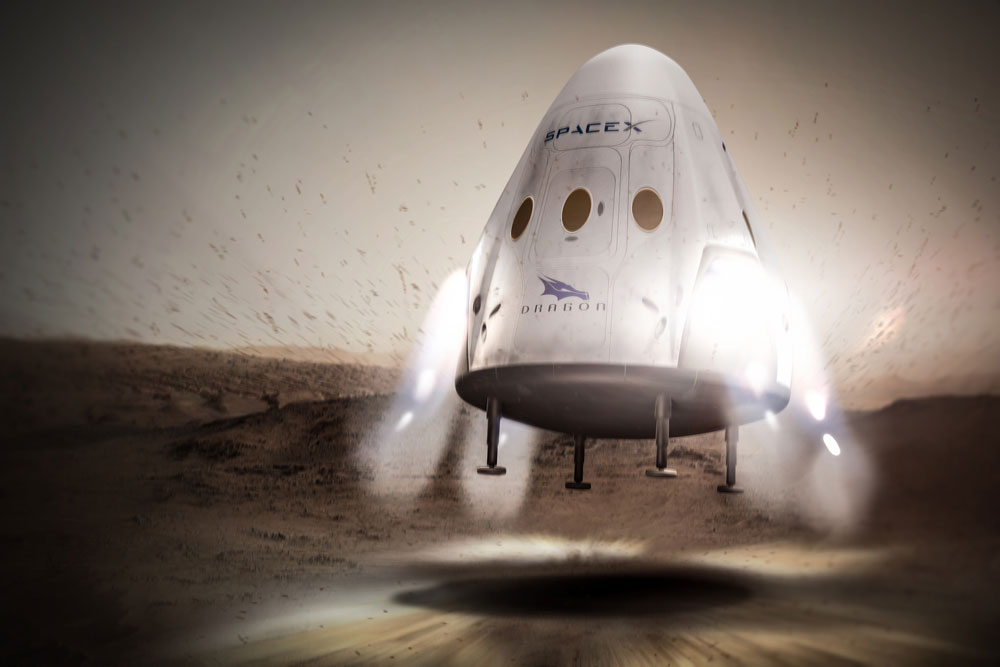How SpaceX's 2018 'Red Dragon' Mission Could Help NASA Put Boots on Mars

SpaceX's planned 2018 Mars mission could pave the way for a few different types of boot prints on the Red Planet.
The California-based company aims to launch one of its uncrewed Dragon capsules toward the Red Planet in May 2018, to test out some of the technologies needed to make SpaceX's ambitious Mars-colonization goal a reality.
One of those technologies is "supersonic retropropulsion." Dragon will hit the Martian atmosphere going far faster than the speed of sound; the capsule will use its onboard SuperDraco thrusters, rather than parachutes, to slow down enough to land. [SpaceX's Red Dragon Mars Mission in Images]
No Red Planet effort has ever relied upon supersonic retropropulsion. But NASA views the strategy as key to enabling human Mars missions, which will require putting extremely heavy payloads such as habitat modules down on the planet's surface. (NASA's 1-ton Curiosity rover, which touched down in August 2012, pretty much maxed out the agency's daring parachute-sky-crane landing system, agency officials have said.)
"Every single candidate EDL [entry, descent and landing] architecture we have for Mars human exploration relies to some extent on supersonic retropropulsion," Phil McAlister, director of the Commercial Spaceflight Division at NASA Headquarters in Washington, D.C., said Wednesday during a presentation with the agency's Future In-Space Operations (FISO) working group.
So NASA is keen to see how Dragon's ride through the Red Planet's skies goes. That helps explain why the space agency is providing technical support to the 2018 "Red Dragon" mission in a range of areas, from deep-space communication to the drafting of "planetary protection" protocols designed to reduce the risk of contaminating Mars with Earth microbes. (NASA's support does not include funding, as SpaceX is paying for the mission.)
In return for this help, NASA will receive "most of SpaceX's entry, descent and landing flight data," McAlister said. "This is a critical, critical technology for us, and this is flight data that would not be available to us [by] any other means.
Breaking space news, the latest updates on rocket launches, skywatching events and more!
"So this was a unique opportunity for NASA to partner on a mission that we could not otherwise do," he added, referring to the collaboration as a "win-win" for SpaceX and NASA. "Could we do one like this in the future? Sure, but we don't have one on the books right now. It's not funded and, to my knowledge, hasn't even been proposed."
NASA aims to get astronauts to the vicinity of Mars before the end of the 2030s. SpaceX is working on a more aggressive time line; if all goes according to plan, the company hopes to launch the first Red Planet pioneers in 2024, SpaceX founder and CEO Elon Musk has said.
Musk has stressed repeatedly that he started SpaceX back in 2002 primarily to help colonize Mars, thereby making humanity less vulnerable to asteroid strikes and other calamities that could wipe out the species.
Whereas the 2018 mission will rely on Dragon and SpaceX's in-development Falcon Heavy rocket, SpaceX's crewed Mars efforts will employ an entirely different architecture, known as the "Interplanetary Transport System" (ITS).
Musk has said he will unveil details of the still-mysterious ITS, and the company's broad humans-to-Mars ambitions, next Tuesday (Sept. 27) during a presentation at the International Astronautical Congress meeting in Guadalajara, Mexico.
Follow Mike Wall on Twitter @michaeldwall and Google+. Follow us @Spacedotcom, Facebook or Google+. Originally published on Space.com.

Michael Wall is a Senior Space Writer with Space.com and joined the team in 2010. He primarily covers exoplanets, spaceflight and military space, but has been known to dabble in the space art beat. His book about the search for alien life, "Out There," was published on Nov. 13, 2018. Before becoming a science writer, Michael worked as a herpetologist and wildlife biologist. He has a Ph.D. in evolutionary biology from the University of Sydney, Australia, a bachelor's degree from the University of Arizona, and a graduate certificate in science writing from the University of California, Santa Cruz. To find out what his latest project is, you can follow Michael on Twitter.

